Non-Small Cell Lung Cancer
Non-small cell lung cancer (NSCLC) is the most common type of lung cancer, accounting for more than 8 out of 10 cases. NSCLC is aggressive, but treatments like surgery, chemotherapy, and immunotherapy can help patients live longer or become survivors. Learn more about this type of lung cancer and how our team can help you cover treatment costs below.
What Is Non-Small Cell Lung Cancer?
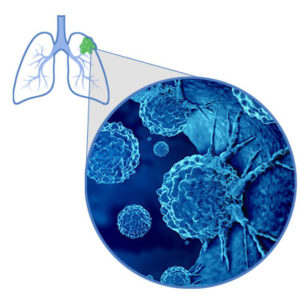
NSCLC is the most commonly diagnosed lung cancer type. It’s projected that more than 187,000 lung cancer patients will be diagnosed with NSCLC in 2024.
NSCLC develops when cells in the lungs mutate and multiply at out-of-control rates. Common causes of lung cancer include smoking and exposure to asbestos.
Getting diagnosed early and receiving prompt treatments are key to living longer with this cancer. There are many treatment options for NSCLC — even if you were diagnosed after the cancer has spread.
Further, you might qualify for financial aid if you or a loved one has NSCLC or any other type of lung cancer. Get started right now with a free case review.
- Access Financial Aid and Justice
- Learn About Your Options
- Contact Us for Free

Non-Small Cell Lung Cancer vs. Small Cell Lung Cancer
Non-small cell lung cancer is one of two main types of lung cancer, the other being small cell lung cancer (SCLC).
Each type is unique and may require a different treatment approach than the other.
NSCLC and SCLC have many other differences, such as:
| Attribute | NSCLC | SCLC |
|---|---|---|
| Cancer Spread | Spreads less quickly | Spreads very quickly |
| Rarity | Very common, making up over 80% of all lung cancer cases | Uncommon, accounting for 10-15% of lung cancer cases |
| Treatments | Many treatment options available, most notably surgery | Fewer treatments available and surgery is rarely used |
What Causes Non-Small Cell Lung Cancer?
Smoking is the main cause and biggest risk factor for NSCLC. Up to 90% of non-small cell lung cancer cases are caused by smoking, according to the U.S. National Library of Medicine.
Those who regularly smoke cigarettes for years or decades have the highest risk of lung cancer.
Secondhand smoke and exposure to other toxic substances like asbestos, radon, or severe air pollution can also put someone at higher risk of NSCLC. These factors often account for cases of NSCLC in nonsmokers.
How Does Asbestos Exposure Cause Non-Small Cell Lung Cancer?
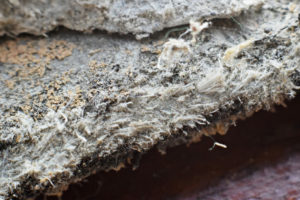

Asbestos is a fiber-like material that was used in many products between the 1930s and early 1980s before the risks were publicly known.
You could have breathed in airborne asbestos fibers while working with or around these products.
The fibers could then get stuck in your lungs, damaging normal cells and mutating them into NSCLC cells 10-50 years later.
Tragically, many cases of asbestos-related NSCLC could have been prevented. Manufacturers of asbestos-containing products knew the dangers of asbestos in the 1930s but hid the deadly facts to keep their profits high.
At Lung Cancer Group, we find this corporate negligence unacceptable. Call (877) 446-5767 now to learn if you can pursue financial aid and justice for NSCLC.
Non-Small Cell Lung Cancer Symptoms
Symptoms of non-small cell lung cancer vary depending on how far it has spread.
- Appetite loss
- Chest pain
- A cough that won’t go away
- Fatigue
- Shortness of breath
- Weight loss
However, the U.S. National Library of Medicine notes that NSCLC patients may not have any symptoms if the cancer is in its early stages. Many patients only start to notice symptoms by the time the cancer has spread.
- Drooping eyelids
- Hoarseness
- Pain in the bones
- Shoulder pain
- Swelling in the face
Those at risk of NSCLC are highly encouraged to get regular lung cancer screenings — even if they don’t have symptoms yet. These screenings may allow doctors to catch cases of NSCLC before symptoms appear.
How Is Non-Small Cell Lung Cancer Diagnosed?
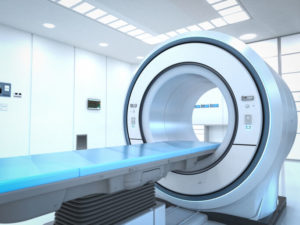

Doctors can use several different tests to diagnose NSCLC. First, they may check for lumps under your skin with a physical exam. They’ll also want to know if you smoked or were exposed to other toxins like asbestos and if you have any family history of lung cancer.
Doctors will then look inside your body to check for signs of cancer, such as masses or growths, with imaging scans.
Imaging scans used to help diagnose NSCLC include:
- CT scans
- MRI scans
- PET scans
- X-rays
If doctors detect abnormal growths after these tests, they’ll perform a biopsy, which is the only way to confirm a NSCLC diagnosis.
With a biopsy, doctors remove a sample of fluid or lung tissue using a needle or bronchoscopy (thin tube with a light at the end). The sample is reviewed under a microscope to see if you have NSCLC or another type of cancer.
Non-Small Cell Lung Cancer Staging
There are five stages of non-small cell lung cancer, according to the American Cancer Society. Stage 0 is the least advanced, while stage 4 is widespread.
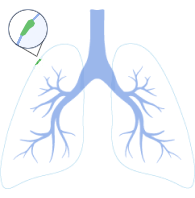

Stage 0
In stage 0 non-small cell lung cancer, tumor cells are only found on the top part of the lung lining. This is the easiest stage of NSCLC to treat as the cancer hasn’t spread.
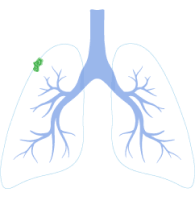

Stage 1
In stage 1 non-small cell lung cancer, a tumor has started to form.
There are two substages based on the size of the tumor:
- Stage IA: Lung tumors are less than 3 centimeters wide.
- Stage IB: Tumors are no larger than 4 centimeters wide and may have grown into one of the bronchi (tubes that push air from the windpipe into the lungs) or the outer part of the pleura (lung lining).
Stage 1 NSCLC patients often qualify for many treatments, most notably surgery, to help them live longer or cure them.
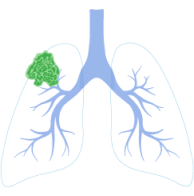

Stage 2
Stage 2 non-small cell lung cancer tumors have gotten larger and started to spread.
There are two substages:
- Stage 2A: The cancer tumors are bigger than 4 centimeters but not quite 5 centimeters.
- Stage 2B: Tumors are bigger than 5 centimeters or less than 5 centimeters and have reached the lymph nodes, allowing them to spread to other parts of the body.
Doctors can often still treat stage 2 lung cancer cases effectively with surgery or other therapies.
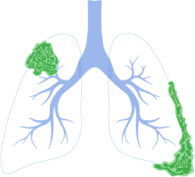

Stage 3
Stage 3 non-small cell lung cancer has spread further, reaching lymph nodes and other parts of the body.
There are three substages:
- Stage 3A: The tumor may have reached the inner part of the pleura, mediastinum (space between the lungs), heart, windpipe, or diaphragm.
- Stage 3B: The cancer has grown into lymph nodes around the collarbone or carina (where the windpipe separates into two bronchi) as well as the backbone, heart, and other areas from Stage 3A.
- Stage 3C: Cancer has spread to lymph nodes on the other side of the body as well as body parts from the earlier stages.
This stage may or may not be treatable with surgery. Doctors will likely recommend other treatments (such as chemotherapy) to shrink lung tumors and help patients live longer.
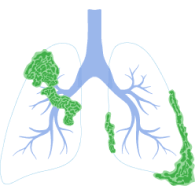

Stage 4
This is the most advanced stage, as it has spread to distant parts of the body. It is also known as metastatic or advanced non-small cell lung cancer.
Its substages include:
- Stage 4A: The cancer is found in the lungs as well as in one area outside of the lungs.
- Stage 4B: The NSCLC tumors are found in multiple organs outside the lungs (like the bones, brain, or liver).
Between 60% and 70% of NSCLC patients are diagnosed in this stage, according to a 2021 study published in Frontiers in Oncology.
Stage 4 NSCLC is the hardest stage to treat. However, skilled lung cancer doctors will do all they can to help patients, and it’s possible to become a stage 4 NSCLC survivor.
Get a free case review to learn how we can help you afford lung cancer treatments no matter which stage you’re in.
- Access Financial Aid and Justice
- Learn About Your Options
- Contact Us for Free




What Are the Subtypes of Non-Small Cell Lung Cancer?
Non-small cell lung cancer cases can be classified into different subtypes. Learn about these subtypes below.
Adenocarcinoma
Adenocarcinoma forms in the cells that line the alveoli (tiny sacs at the end of airways), according to the National Cancer Institute (NCI).
It is the most common NSCLC subtype, accounting for 40% of cases. Doctors are more likely to diagnose this subtype before it has spread.
Squamous Cell Carcinoma
Squamous cell carcinoma is the second-most common NSCLC subtype, accounting for 25% to 30% of cases. It forms in the bronchi (tubes that push air from the windpipe into the lungs).
It is more commonly linked to smoking than the other subtypes. Tumors in this type typically spread less quickly than other NSCLC subtypes.
Adenosquamous Carcinoma
This is a rare subtype, accounting for 0.4% to 4% of lung cancer cases. Tumors have elements of adenocarcinoma and squamous cell carcinoma. Most patients are older men with a history of smoking.
Large Cell Carcinoma
Large cell carcinoma makes up less than 3% of all NSCLC cases. It serves as a catch-all for cases that can’t be easily classified as one of the other subtypes. Most patients are long-term smokers over the age of 65.
Large Cell Neuroendocrine Carcinoma
Large cell neuroendocrine carcinoma (LCNEC) is a subtype of large cell carcinoma. Between 1% and 3% of lung cancer cases are LCNEC. Its tumors are made up of both SCLC and NSCLC cells.
LCNEC is harder to treat than other subtypes, resulting in patients not living as long with these subtypes compared to those with other subtypes.
Sarcomatoid Carcinoma
Sarcomatoid carcinoma is very rare, making up 0.1% to 0.4% of all NSCLC cases. Most patients are diagnosed when they’re in their late 60s.
This subtype responds poorly to chemotherapy and radiation, so doctors often treat patients with surgery, as well as immunotherapy and targeted therapy.
Pursue financial aid for any subtype of NSCLC right now. Call (877) 446-5767 to find out your eligibility.
What Is the Prognosis for Non-Small Cell Lung Cancer?
A prognosis is your projected health outcome after being diagnosed with an illness. Though non-small cell lung cancer often has a poor prognosis, it’s possible to be fully cured and live cancer-free in some cases.
A lung cancer prognosis is measured with two factors: life expectancy and survival rate. Learn about each below.
Non-Small Cell Lung Cancer Life Expectancy


NSCLC life expectancy varies depending on stage, subtype, and the treatments a patient qualifies for. That said, some patients have lived for many years or even decades with the right treatments.
Patients are encouraged to explore all their treatment options after a diagnosis. Without treatment, the average NSCLC life expectancy is just over 7 months, according to a study published in the journal Systematic Reviews.
Survival Rate for Non-Small Cell Lung Cancer
Survival rate is the number of patients still alive after a set time (usually a certain number of years). The overall 5-year NSCLC survival rate is 28%, according to the American Society of Clinical Oncology (ASCO).
Like life expectancies, lung cancer survival rates vary greatly depending on cancer stage, treatments, and other factors.
- Patients with localized (early-stage) NSCLC have a 5-year survival rate of 65%.
- Patients with metastasized (late-stage) NSCLC have a much lower 5-year survival rate of 9%.
Lung cancer treatments are the best way to improve your survival time.
Non-Small Cell Lung Cancer Survivors
Non-small cell lung cancer is not a death sentence. By working with medical experts, you may be able to become a long-term survivor.
NSCLC survivors include:
- Anita: Following her diagnosis in 2013, Anita lived for nearly 7 years with stage 4 NSCLC thanks to immunotherapy.
- Jim: Jim was diagnosed with stage 3B NSCLC in 2005. His doctors used a combination of surgery, chemotherapy, and radiation for treatment. He is still alive today, nearly 20 years after his diagnosis.
- Lisa: Lisa was only in her early 40s and had never smoked when she was diagnosed with stage 4 NSCLC in January 2014. Doctors treated her with chemotherapy and targeted therapy, and she recently became a 10-year survivor.
“Each year, tens of thousands of people are cured of NSCLC in the United States. And, some patients with advanced lung cancer can live many years after diagnosis. Sometimes patients who are told that their lung cancer is incurable live longer than many who are told that their lung cancer is curable.”
— American Society of Clinical Oncology (ASCO)
We can help you afford top treatments that may help you survive NSCLC if eligible — learn more with a free case review.
- Access Financial Aid and Justice
- Learn About Your Options
- Contact Us for Free




Non-Small Cell Lung Cancer Treatments
Treatments for non-small cell lung cancer can help you live longer, ease your symptoms, and improve your overall quality of life. You may be able to pursue NSCLC treatment options even if your cancer is in an advanced stage.
Your cancer care team can recommend treatments based on the specifics of your diagnosis. Learn about top lung cancer treatments below.
Surgery
Surgery is arguably the best treatment for NSCLC. It allows doctors to remove all or most cancer tumors, improving the odds that a patient will become a long-term survivor.
Types of surgeries used to treat NSCLC include:
- Lobectomy: In this common lung cancer surgery, the entire lung lobe (one of five chambers that make up the lungs) that a tumor grew on is taken out. The ASCO notes that a lobectomy is the most effective NSCLC surgery.
- Wedge resection: Doctors remove the tumor and nearby lung tissue that surrounds it.
- Segmental resection: Also called segmentectomy, this is similar to a wedge resection, but more lung tissue is removed. Doctors may also remove nearby lymph nodes. It is often performed if lobectomy can’t be done.
- Pneumonectomy: This removes the entire lung where the tumor formed. It may be recommended if the tumor can’t be removed with a lobectomy or if it’s located in the middle of the lung.
- Sleeve resection: Doctors take out part of the cancerous bronchus and the tumor. The noncancerous ends of the bronchus are reattached. This surgery may allow a patient to avoid a pneumonectomy.
However, if a patient is diagnosed with stage 3 or stage 4 NSCLC, the cancer might be too widespread to remove with surgery. Doctors can then use other lung cancer treatment options to help patients live longer.
Chemotherapy
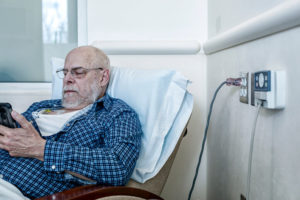

Chemotherapy medications circulate through the body to destroy cancer cells and shrink lung tumors. Oncologists (cancer doctors) typically give chemotherapy in cycles, which involve receiving medication over a couple of weeks, followed by a recovery period.
Many different chemotherapy medications may be used to treat NSCLC, including carboplatin and cisplatin.
Chemotherapy can also be used with other therapies in what’s known as a multimodal treatment plan. In a 2018 study, NSCLC patients treated with chemotherapy and immunotherapy lived for 3 months longer than those who only received chemotherapy.
Immunotherapy
NSCLC (and other types of cancer) can sometimes hide from the body’s immune system and spread rapidly. Immunotherapy boosts the body’s immune system to more effectively destroy cancer cells.
Commonly used immunotherapy drugs for NSCLC include pembrolizumab (Keytruda®) and atezolizumab (Tecentriq®).
Radiation Therapy
Radiation therapy allows oncologists to shrink NSCLC tumors using high-powered beams of energy. It is typically used to treat cases of early-stage NSCLC, as it’s ineffective when the cancer is widespread.
Radiation therapy can also be used as an adjuvant treatment (a supplement to other treatments like surgery) in a multimodal treatment plan.
Call (877) 446-5767 to get help affording lung cancer treatments like radiation. Our team can see if you qualify for financial compensation.
Targeted Therapy
Through targeted therapy, doctors destroy genes, proteins, or other substances that allow cancer tumors to grow and spread.
Types of targeted therapies for NSCLC include:
- Epidermal growth factor receptor (EGFR) inhibitors: EGFRs are proteins that trigger cell growth if other proteins attach to them. EGFR inhibitors stop this process to prevent cancer cells from multiplying.
- Crizotinib (Xalkori®): This drug targets mutations in anaplastic lymphoma kinase (ALK) and ROS1 genes, which make proteins that cancer cells need to survive.
Your oncologists can see which targeted therapies you qualify for.
Other Treatments
Doctors can use several other NSCLC treatments besides those listed above to help patients live longer.
Additional NSCLC treatments include:
- Cryotherapy: Doctors inject a freezing gas into lung cancer tumors, which destroys them.
- Electrocautery: A needle heated up with electricity is used to kill lung cancer cells.
- Photodynamic therapy: A light-sensitive drug is administered that lung cancer cells absorb. Then, bright light is applied, killing the cancer cells that absorbed the drug.
Your NSCLC health care team can determine which of these treatments (if any) will be of use in your case.
Clinical Trials
Clinical trials allow eligible patients to access new and possibly more effective lung cancer treatments. There are hundreds of active NSCLC clinical trials throughout the United States.
NSCLC clinical trials study:
- Modifications to existing treatments: Researchers can look at different ways to use existing NSCLC treatments in trials. For example, Fox Chase Cancer Center is studying how modified doses of chemotherapy can help NSCLC patients with comorbidities (other health problems).
- New treatments: Clinical trials allow doctors to safely study newer treatments. An ongoing Washington University School of Medicine cancer research study is investigating new immunotherapies to help NSCLC patients whose cancer came back (recurred) after treatment.
- New treatment combinations: Both new and existing treatments can be tested together through clinical trials. A study led by Tufts Medical Center is looking at how immunotherapy, chemotherapy, and a medication called sargramostim can help late-stage NSCLC patients live longer.
Clinical trials may provide hope to patients whose cancer isn’t responding to standard treatments or those experiencing recurrence.
You can find a list of active NSCLC clinical trials by speaking with your health care team. Which NSCLC clinical trials you’ll qualify for depends on your cancer stage, overall health, or other factors.
Palliative Care
Palliative care focuses on easing symptoms of a patient’s illness. Palliative care may be recommended in cases of advanced NSCLC.
Many of the treatments listed earlier (including chemotherapy, surgery, and radiation) can be used as palliative care if they’re scaled down.
For example, a minor surgery or a low dose of radiation can be used to shrink lung cancer tumors and reduce a patient’s symptoms.
Help for Non-Small Cell Lung Cancer Patients
A non-small cell diagnosis is life-changing for a patient and their loved ones.
If you or someone you love is facing a diagnosis, know there is hope because:
- If the cancer is caught early on, it’s possible to be fully cured of NSCLC with surgery.
- Chemotherapy, radiation, and more can also destroy cancer tumors and ease symptoms.
- Many patients have become long-term survivors even when diagnosed in stage 4.
Lung Cancer Group can help you pursue compensation for NSCLC treatments and any other expenses related to your diagnosis. This can allow you to focus on recovering without worrying about how you’ll pay your bills.
Find out your eligibility right now with a free case review.
Non-Small Cell Lung Cancer FAQs
What is the life expectancy of non-small cell lung cancer?
Non-small cell lung cancer has an average life expectancy of 13 months, but you may live much longer depending on how your body responds to treatments.
Many NSCLC patients are considered cured or live for much longer than expected — sometimes for years or decades — with the help of top lung cancer doctors.
Which is more treatable: small cell or non-small cell lung cancer?
Non-small cell lung cancer is usually more treatable than small cell lung cancer. NSCLC is not as aggressive as SCLC, and doctors are often able to use surgery to remove tumors.
That said, there are treatments available for any type of lung cancer. By working with specialists, you may be able to achieve long-term survival — even if you’re diagnosed with late-stage cancer.
Contact our team now for help affording lung cancer treatments.
How serious is non-small cell lung cancer?
NSCLC can be life-threatening, and this is made worse by the fact that 8 out of 10 patients are only diagnosed after the cancer has spread.
Go to a doctor as soon as possible if you might have lung cancer. Quickly getting treatments will give you the best chance of living longer with NSCLC. If you’re diagnosed in the cancer’s early stages, doctors might be able to cure you.
Is non-small cell lung cancer the same as mesothelioma?
No. NSCLC is a different type of cancer entirely from mesothelioma.
NSCLC forms in the lungs and can be caused by smoking, asbestos exposure, and other factors. Mesothelioma develops in the lining of organs (most commonly the lungs) and is only caused by asbestos.
Further, the two cancers must be treated differently. Talk to your doctor to make sure you’ve been properly diagnosed before starting treatment.
Besides lung cancer, our team can also help mesothelioma patients pursue compensation after a diagnosis. Call (877) 446-5767 to find out your eligibility.
Can non-small cell lung cancer spread?
Yes. NSCLC can spread quickly throughout the body without treatment. It often spreads to the bones, brain, or liver, according to the ASCO.
Getting diagnosed and treated before NSCLC spreads is very important, as it will respond to treatment much better in earlier stages.

